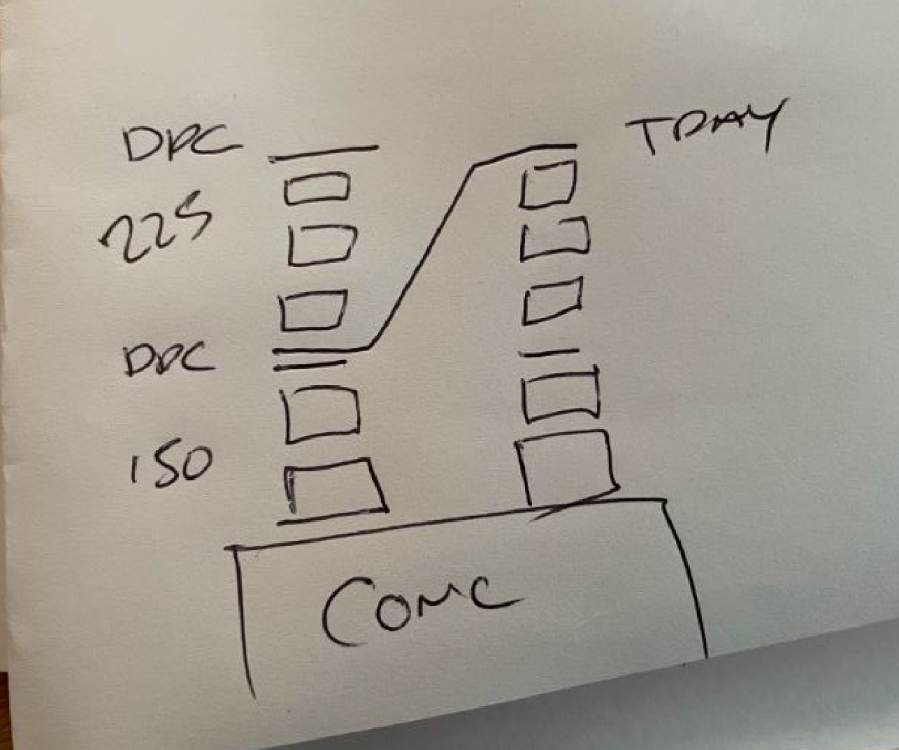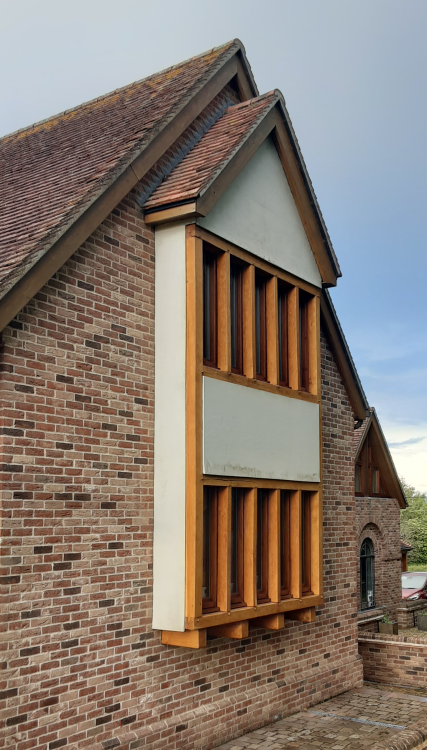Leaderboard
Popular Content
Showing content with the highest reputation on 05/13/23 in all areas
-
The inverter does limit all throughput but it matches its throughput to the house load. It monitors the power leaving the house and as soon as it sees export go above the limit it's been set to, it throttles the throughput so that export stays within set limits. Yes you can export 3.68kw on each of the 3 phases without getting permission via G99. With 3 DNO fuses Id guess youve got 3 phase to the house but the house is only using 1 phase. Youd need a new meter and a new consumer unit to hook up the 3 phase. Except for the meter, your spark should be able to sort out the rest. If youre only looking for 7kw export it would likely be easier/cheaper to stick with single phase unless SPEN object2 points
-
Wired for me, if at all possible - the quinetic stuff looks to be decent and is clever, might be useful for stair / landing and outside lights if you forgot a cable, but a step too far for me to go wireless for everything2 points
-
In my book (white male, <50 years old), you have this the wrong way around. Wired switches are always going to be more reliable and long lasting than wireless, however something digital ("smart") will allow a pair of wires to each switch to have infinite uses, and be software reprogrammable if needs change, without need for a wire per light Like others here I use Loxone, but other options like Rako exist. All that said Lutron have gone wireless only and it is the trend with other tech (ZigBee Zwave Bluetooth and Matter) so maybe I'm the luddite. I just hate wireless tech when a wired option is possible2 points
-
I am not so sure. I would say failed or failing lintel above the bay window. The lintel will be bridging the brickwork, just below downstairs ceiling level and probably the bedroom joists are spanning front to back on that lintel. You could get a surveyor to look at it and give an opinion, but nobody will tell for sure without exposing some of the structure and a surveyor won't do that.2 points
-
Having a good giggle at all the banter.🤣 I don't see how anyone could (he says) argue that burning wood is not carbon neutral but using it and reusing on site for other things, studs, wedges would be best. I'm not sure that transporting the off-cuts to the local Council for them to put it on truck to move it to a pulping factory of wood chip manufacturer is better. Building waste, especially if it's treated can't go to composting for instance due to the nasty chemicals in it. I have worked for waste management at the Local authority so I have, on this occasion, an informed (semi) view.😉 but still open to corrections.2 points
-
Cats & pigeons get ready! We are a long way off planning the wiring runs for our new build but a recent conversation with our electrician neighbour got me thinking about 2 way and 3 way switches for bottom/top and exit out of rooms. The details aren't important unless we have to squeeze 9 cables into a switch box but remote controlled (not smart) light switches have been around for many years so is it time to do away with the wired light switch. I'm sure purists would say no and youngsters (under 50) would get with the times but I don't know if it would be allowed under building regs. What do you think (he says lighting blue touch paper and retiring to safe distance😁) Thinkbee MINI Wireless Light Switch Kit, Quick Create or Relocate On/Off Switch for In-/Outdoor Lamp up to 1000W, No Wiring/Easy-installing/Portable/Waterproof Switch Remote Control Up to 1300ft,1 point
-
I'm just starting out getting PV installers out for assessment / estimates. Any lessons learned? Things you wish you'd taken into consideration? Financially, it's a no brainer as we have no gas supply in the area and a reasonable south facing roof with smaller West facing space. Additional smaller south roof on stand alone garage which I hope to convert to office. Divert to UVC will give me 7 kWh of storage. Summer generation more than we can use but down the line we'll no doubt go EV.1 point
-
I have worked for our local Council as a tree inspector and Japanese Knotweed adviser and treatment coordinator in the Housing Department also dealing with boundary issues but now nearing retirement. Claire and I started looking for land 4 years ago and picked up a corner plot in a quiet village near the Preseli hills, thankfully not in Pembrokeshire national Park. We have a budget of £250k for the build and 3 years along the road with planning permission taking 18 months but it's a difficult site to develop due to seasonal springs, high water table, split level and made-up ground. Wish us luck because we will need it. Going for a Hemp build with MVHR 4Kw air sourced heat pump, and underfloor heating. Solar and battery was planned but as other costs increase some of the 'would like' things are being crossed off the list. The log burner was crossed off yesterday after reading this forum. I hope I can contribute to the forum and share what knowledge I have as well as learn from your experiences.1 point
-
As I've pointed out before, doors are inherently splash-proof so the requirement is different to masonry. I.e. non-existent. The real issue is how well the door and casing can resist wind-driven rain. Sliding doors are excellent in this regard as they run in a recessed, drained, channel.1 point
-
You will have to compare the m2 prices of the different system. Much of it does depend on how much you can get PV roof trays for, seems they can vary is price by a factor of 3 if you are not careful. Have a search here for GSE stuff. There may be cheaper suppliers.1 point
-
Mitsu 11 or Pana 12 will both deliver the output needed low temp, over 5Celsius the Mitsubishi will have about 4kW minimum output vs about 6kW Pana(that's because 12 and 16 sizes use the same compressor) ideally the lower the better. The focus should be on having as much radiating surface for best results, underfloor, walls, ceiling, radiators. Mitsu is made in UK, it is liked by people and I bet on it to wide spread in UK to benefit the future servicing/warranty/spares/skills, as well as community. Pana is liked overall in western Europe. Plan carefully on the size needed and focus on the right pairing of radiating surface.1 point
-
No, AFAIK A2W units are rated on the output power too, the electrical input is of the order of 1/3 of the output (for a CoP of 3).1 point
-
Imho at least put some conduit drops / boxes in, even if you go wireless.1 point
-
1 point
-
FWIW I went Mitsubishi Electric (Mitsubishi Heavy is a completely different firm - perhaps everyone knows - was news to me) A2A context. A lot of the decision weight based on my installer and his shortlist of recommendations against mid-high price point and his experience working with brands. My thinking was I can go in with a shortlist in mind which included both brands mentioned above - but at the end of the day the installer will always have more on the ground experience. (assuming you find a good one) Its also interesting the A2A units seem to be primarily labelled based on energy output, whereas A2W energy input - or is that just me? e.g. A 10kW A2A means it can drive up to ~10kW of inside units but only draws about 2kW energy, again inside units primarily labelled on energy output. Am I correct in thinking a 6kW A2W draws up to 6kW1 point
-
I feel your pain. The longer things take to happen the more mistakes seem to evolve. Good luck😄1 point
-
We've got the same DNO as you, SPEN, but likely a different engineering office as we're in N Wales. We had informal agreement to double our export from 3.68 to 7.4kw within a few days. Formal offer took a month or 2 but nothing like 9 months. Definitely speak to them as theyll likely be able to give you an idea of the export theyll allow over the phone. If you are constrained by what you can currently export, theres 2 things to remember. First you can have a big system with export limitation so you could have an inverter/batteries that will feed 7kw to the house but is limited to 3.68kw to the grid. Second is that the rules on who pays for grid reinforcement have just changed so if theres export limitation because of grid capacity, the DNO pays for upgrades whereas previously the customer often did1 point
-
Yes, 3.68kW if you go the G98 route. Back on topic, the one thing I'd change is to go G99, there are a few more fast track options now which let you get to 7.36kW which would save some complicated battery management I've set up to ensure capacity remains for excess PV when the inverter is running full whack. Ask the DNO early, no point putting 16kWp panels up if they say no to anything but G98.1 point
-
I've now had a few Installers out and one quote back. Given the advice to go big (and benifits from vat saving), I'm trying to wrap my head around the inverter piece /G99. One installer quoted for 5.2 kW system with giv 3.6kW inverter and 2x5.2kW giv batteries. Am I correct to think that 3.6 inverter means I could not use more than 3.6 KWh concurrently from either the battery or the panels? That would be very limiting in the winter months. They also mentioned a bigger sized system at 13.5kW was feasible and even 16kW if we used West facing roof as well. The advice was start with a small system and upgrade later as G99 could take 9 months. Anyone have any time lines on Scottish power g99 application? If G99 was rejected does that then limit me to 3.6 inverter or is there alternative configurations. It would seem crazy to upgrade later at higher cost. Lastly - does three phase come into the equation at all? I think we have three phase (eco 7) but need to work out how to confirm. Thanks1 point
-
Not sure building control care as long as you have a sign off cert from the electrician. Just seems more stuff to go wrong and scratch your head over in 10 years time when it's all old hat, the company no longer supplies the replacement parts.1 point
-
1 point
-
while @SteamyTea is reading this weeks scientific, i am sitting eating my toast wondering.... Wood when growing stores carbon. When we burn it, is all that released back into the air ? Don't all chuckle, i went to a good catholic school where very little science was taught, because god did it all.1 point
-
The fact your "electrician" could not figure that out shows his lack of competence. So progress at last. Quite probably all you have to solve now is getting a proper feed to the bottom CU without that over crowded mess in the main switch, allocating the circuits properly and testing them properly as you go, and getting some form of RCD protection to the bottom board.1 point
-
A couple of the fancoil companies advertise 'light cooling' mode, basically keep the flow temp above the dew point and lightly blow air over the radiator. It's entirely plausible that this is sufficient to make a difference in the UK climate and could be done by adding accessory fans to ordinary radiators.1 point
-
To back that up, look at this very limited sample of users posting their results and you can see that the two most popular makes/brands are the best and the worst! https://heatpumpmonitor.org/ also your installation config can make a big difference. I have a good installation but my microbore + radiator refit will never be able to achieve greater than COP 3.5, whereas a new or complete re-build with UFH can get above COP 4.51 point
-
A good stir to get us going today! No, I think you burned it because it was cheaper than a skip and macho fun. Reusing it would be neutral. Does the council accept wood as a separated product?1 point
-
its second fix where the waste piles up. Masses of cardboard, styrophome, plastic etc. All of which is needed to protect the material in transit. During build there is relatively little waste upto 1st fix on a traditional build. Just plastic wrap, cement bags, straps, and pallets etc. 1 skip was plenty on our 4 bed. second fix easy fill a couple skips if you dont have a machine on site to squash it down. Burned any waste wood as its carbon neutral.1 point
-
I think a basement would be too expensive for us to be honest. the planners have indicated a 2 bedroom property would be preferable, however we would like to push this to 3 (plus a small box room for guests/study). Our neighbours property was described as a 2 bed yet has a large study, separate dining room, etc so hoping we can frame some of the rooms as study and playroom?? we would like a large kitchen/diner/living area and then 3 decent sized bedrooms (not huge but enough to fit a double bed when kids become adults). One bedroom with en suite and a family bathroom. We would also really like a utility room, even if v small. We aren’t too fussed about a garage, but would need some kind of storage area. One of the big things for us would be lots of light and a good connection to the garden.1 point
-
Exactly this, with masses of insulation in a house suitable for ASHP's summer overheating is likely. I am building my system around cooling being used 50% of the year and am frustrated by the lack of cooling on the BUS so have just bought my own direct. I suspected the government have stipulated this to prevent the BUS being used to install cooling systems that never get used to heat.1 point
-
what you need is a vertical DPC. This is a cavity tray that allows you to 'move' the dpc higher up the wall. This allows a fully level threshold (with a suitable cill) and not having to worry about the normal 150mm limit. Same is used where you are building against sloping ground and need to protect the 'upslope' wall. Unless of course its a front door and they are automatically immune to the 150mm rule !! We have done this for every build as it costs peanuts and gives total flexibility. The example here moves DPC 225mm higher than normal.1 point
-
1 point
-
This is a difficult subject to get your head round to say the least. Hope these general comments help shed some light. You want to do a loft conversion that turns you house from a two storey into a three and you have non rated doors, say traditional 6 panel timber doors with fielded panels. Timber and in particular hardwood doors (the timber is denser) can resist fire quite (talking 30 minutes here) well as the timber chars on the fire side and the charring provides an insulating layer which keeps the remaining timber cooler and thus intact. But you need a sufficient thickness of timber so you can get enough char to do the job. 32mm thick look a bit thin to me, if all other factors work in your favour then the Institution of Fire Engineers mention a figure of 35mm thick if the door has that thickness all over.. in other words a solid door. For me I would look at this as a possible practical / cost effective option for a non period house if the doors were 45mm thick or more and solid. A fielded panel is much thinner, that is a problem. Now it gets more complicated.. you can protect the fielded panels but you need to understand how the panels are rebated into the styles, rails and muntins. Next you need to examine each door for distortion, splitting and so on. Next we need to look at how we are going to install cold smoke seals and heat (intumescent heat) seals... do we fit them to the doors or the frame? Onto the door frame now. Do we have enough meat in the timber to fit hinges and closers in accordance with the manufacturer's instruction? How thick is the door frame, is there a gap behind it and how thick are the door facings protecting the masonry frame interface? The above covers some things we need to think about. In the old days we used to fit hardwood stops screwed and glued to the existing frame, maybe upgrade the fielded panels a bit and pretty much go to the pub. Changed days now as this sort of stuff is well scrutinsed, rightly so. To get this over the line with BC you need to do your research, develop the upgrade strategy, make the case, make sure your case will stand up to test by say the Institute of Fire Engineers and then hope that BC will agree. Anyone doing this type of design / upgrade carries the can liability wise so the days of doing ten minutes work and scooping up are over. Now the above can be challenging and exciting.. but it comes at a cost. The objective is to provide a passage way (protected route) to allow people on the ground and first floor (if not too high above the ground to jump out a window, it's the height to ground level) to escape. On the third floor they escape by way of the stair case. Thus for now assume you need fire doors on all the rooms (sometimes not all rooms but that is for another day) connecting to the staircase so that if a fire starts in one room the smoke and heat can't get into the stair well. Another thing we need to think about is this. When we create a third storey in the attic the attic floor becomes a structural floor.. that needs a 30 min fire resistance from below. If the ceiling joists are thin then sometimes you can't show that 12.5mm plasterboard directly fixed to say prefabricated truss bottom chords (89 x 38) gives the 30 min fire protection. But if your house was built with future proofed attic trusses the bottom chords may be 195 x 45 which usually gives you 30 min fire protection. It's not just the plasterboard alone that gives the 30 min it's also what it is fixed to and whether the plasterboard is skim coated or not. You can get round this by beefing up the ceiling joists if they are thin.. but you need to check the strengthening nailing pattern etc. If you have lath and plaster ceilings that BC query there is a fairly cheep fire emulsion paint that you can apply to upgrade a lath and plaster ceiling to 30 min or more. The above all sounds a bit doom and gloom.. but here a few ideas. Often when doing a loft conversion folk also want to make things open plan on the ground floor.. in new build you may have open plan ground floor also... both play havoc with the protected stair concept. But now we have misting fire sprinklers! The price has dropped a lot and they don't need huge tanks in the loft or a "special" water supply. Yes they do need maintained so there is a cost there. Hope this helps a bit.1 point
-
The DPM/DPC is meant to be 150mm above ground level to prevent rain splashing up above it. If you find another way to prevent it splashing it should be OK. Some people put a channel filled with gravel. Lots of example photos in here.. https://www.pavingexpert.com/splash_strips1 point
-
A technique I learned from Germany with thin coat render (especially on ewi) was to apply a first layer of basecoat which you apply with a toothed (8mm usually fine) at an angle. Let this set and then apply another coat within which you embed the mesh.This way it's easier to ensure the mesh is at the correct and uniform depth, especially if, like me, you're not well practised at it. But it also makes it easier to avoid this situation by applying by the meter with each application of mesh. I've also found that this second coat seems to stay wet for a little longer too.1 point
-
If you want new external oak to be a nice honey colour and stay like that I recommend one coat of Danish Oil then several coats of Osmo UV Protection Oil. The Danish oil will make the Oak slightly less white and more honey colour over a few days. The Osmo keeps it that way. If you just use Osmo I find it can look a bit too white. Dainish Oil on its own is a nightmare. Needs recoating every year, even twice a year sometimes so I don't recommend that. The Osmo is good for 4+ years. If you buy Osmo UV Protection Oil online some places have a 20% extra free. eg a 3L tin for the price of 2.5L. I just got a tin from.. https://www.decoratingwarehouse.co.uk/osmo-uv-protection-extra1 point
-
Have you ever had a look at the parasitic losses on an EV? I think I read (may have been about Our Jeremy's Model 3) that they can easily chew through 3 kWh/day. So around 125W while doing nothing. So you may be better off, if your tariff allows, charging it later.1 point
-
I don't like the sound of that. Although I don't have an EV I feel I need to buy a dumb, simple unmetered EV charge point ready for when I might need one, ready to fit when I need it without having a smart meter. I hear talk of EV chargers needing to "communicate" with someone or something. Not at this house they won't1 point
-
But the vast majority of EV charging will be from the grid. I assume/hope that any PV input into the charger will be downstream of the meter??1 point
-
Yes - and some would say 'but why should I pay VAT on power I generated myself'1 point
-
I suspect because this will be something of a square wheel. Imagine paying the £100s, possibly £1000s, of quid I pay in fuel duty every year as a one off payment. It will have to be based on distance traveled and probably when traveled and by what road type as well.1 point
-
Set me wondering how the taxation of EV charging, along shortly I am confident to replace fuel duty, will work if you do it via your PV as you won't be able to insert it after the meter on your EV charge point.1 point
-
put all of the saw dust created from grinding the stump into sturdy black bin bags and advertise it on market place. i filled 20+ bags and gave them all away, i could have given 100 bags away. if you can dig around the stump the grinder will be able to reach a deeper depth. i have a similar predicament so am watching to see how you get on. i think the digger bucket will snag on all the old roots and rip the ground to bits leaving terrible trenches.1 point
-
My neighbours has built a large extension and must have a pallet of cut blocks that will just be used as hard core. Don't forget the savings on air-tightness and no cavity wall insulation. Plus you get a saving on thermal mass and no mold or condensation to deal with, it all adds up.1 point
-
Hi, we wanted a standing seam roof and priced in a zinc roof but Covid and the timber/energy hikes have put that out of reach so ended up with coated steel. Definitely want solar but the budget is so tight that as things get more expensive other things get dropped. Some of the windows are now fixed glazing and Oak floors will be replaced with stone tiles. We are having to be very pragmatic with choices.1 point
-
I’d say go for the things that ultimately will save you money long term . Lots of insulation , pv , ASHP , ufh If funds permit ; battery and EV ( depending on your requirements ) Everyone loves toys 🧸 !1 point
-
Good morning and a very warm welcome to THE self build forum, I originally wanted to build in straw bales but came round to brick and block and I am now glad I did. I too have a woodstove and would not be without one, I also have a 4kW ASHP and MVHR. Best of luck with this and ask away about things, remember there is no such thing as a stupid question, stupid is not asking (and we have all been there). 👍1 point
-
Welcome. Your advice on trees and knotweed will be useful. Rethink the PV. Infact, design the roof around it. With roof integrated, it need not cost any more than tiling/slating.1 point
-
Welcome to THE forum, not that much of an echo chamber, for people like us - looks like a grand plan.1 point
-
This video will explain phase compensation and how it works with/without batteries: https://www.youtube.com/watch?v=pTfOYlboarw. The decision you have to make is: 1) Will loads be connected to one phase only or all phases? 2) Do you want i) single-phase AC-coupled PV inverter ii) i) three-phase AC-coupled PV inverter iii) DC MPPT's. 3) In the future will you use a packaged battery/inverter solution (e.g. powerall) or a hybrid inverter + batteries. 4) Aside from storage size of batteries, you need to think about power in kW that you require from a battery storage system. Which type of PV system you use depends on required power output and what battery you plan to use. A couple of examples: - If you plan to use Tesla Powerall(s) which provides 13.5kWh and 5kW per battery (and supports phase compensation) then you best option would be AC-coupled PV inverter. - If you planned a Victron system then both DC MPPTs and AC coupled PV inverter would work, but it's likely cheaper and simpler to use MPPT. Victron system can be system to any storage size or power output and also support phase compensation. - If you planned to use a all-on-one hybrid inverter then this would work wthout an AC coupled PV inverter and you could buy this now without batterie and then add batteries later. If would be important though to ensure it supported i) sufficient kW output ii) phase compensation if you have loads on all phases. The SunSync hybrid inverter you have been quoted for is single-phase. You could defintly use this if you wanted to, the only issue with this approach is that you're future battery storage would be on a single phase and you house load may (?) be split across three loads. Unless you have very high loads or any three-phase equipment you could keep everything on a single phase which would simplify things. SunSync do do a three phase version too https://www.sunsynk.org/3-phase-hybrid-inverter1 point
-
That's insane, mine was £500 for three pits and engineer supervised. I think you should look at different building forms, because if they are charging that much for a simple dig and report, who knows what they'll charge for anything else out of contract?1 point













